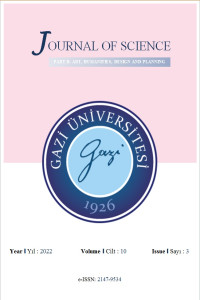Öz
Kasimir Malevich (1878-1935), the modern era Russian artist, brought up the abstract art movement, called suprematism by him, at the beginning of the 20th century (about 1910s). He is a well-known representative of abstract art in the context of suprematism in the modern era. Malevich reduces painting to geometric forms with suprematism. By doing so, the artist purifies the painting from all nature and elements. The artist wanted to carry out the painting art to the zero point with his geometry-based suprematist works, and with this idea, he objected to the mimetic painting tradition in Europe. However, Malevich’s suprematist art thought would not last long; later, he left his suprematism idea and returned to all traditional art and aesthetic values that he had criticized before the 1930s. Actually, it was not an inconsistency. It was a renunciation of revolutionary and innovative things. In a way, because of the Russian Revolutions, which took place in his era, the art policies of the state and the audiences in his society motivated him to return to figurative painting again. From another point of view, Malevich gave up the non-figurative painting in the suprematist approach for the sake of his nostalgia because of his past of art education and returned to figurative painting. Therefore, there is a paradoxical situation in Malevich’s example.
Anahtar Kelimeler
Kasimir Malevich Paradox Suprematism Stereometry Pure Art Abstract Art.
Kaynakça
- [1] Anonymous, (1997), Eczacıbaşı Art Encyclopedia, Volume 3. Yapı-Endüstri Merkezi Publications, Istanbul.
- [2] Antmen, A. (2013), Trends in 20th Century Western Art, Sel Publications, Istanbul.
- [3] Batur, E. (2002), The Adventure of Modernism, Yapı Kredi Publications, Istanbul.
- [4] Crone, R. And Moos, D. (1991), Kasimir Malevitsch, Published by Raction Books Ltd. london,
- [5] Gerier, H. E. (2003), The End of Painting, Utopya Publishing House, Ankara.
- [6] İpşiroğlu, N. and M. (1993), Revolution in Art, Remzi Bookstore, Istanbul.
- [7] Lunacharsky, A. (2000), Revolution and Art, Inter Publications, Istanbul.
- [8] Lynton, N. (2004), The Story of Modern Art, 3rd Edition, Remzi Bookstore, Istanbul.
- [9] Malevich, K. (2011), “Non-Objective Art and Suprematism”, Art and Theory 1900-2000 An Anthology of Changing Ideas, Ed. Charles, H. and Wood, P., Küre Publications, Istanbul.
- [10] Malevitsch, K. (2003), TheNon-Objecrive World The Manifesto of Suprematism, Dover Publications Inc. Mineola, New York.
- [11] Nakov, A. (2000), Our World of Art, issue: 6, Yapı Kredi Publications Istanbul.
- [12] Perrie, M. (2003), Russian Revolution, Revolutions in the West and Revolutionary Tradition 1560-1991, (Ed. David Parker), Dost Publications, Ankara.
- [13] Tilly, C. (2005), Revolutions in Europe 1442-1992, Literature Publications, Istanbul.
- [14] Tunalı, İ. (1996), Modern Painting in the Light of Philosophy, 5th Edition; Remzi Bookstore, Istanbul.
- URL-1. https://commons.wikimedia.org/wiki/File:Kazimir_Malevich_-_Suprametism.jpg(Access Date: 07.10.2020)
- URL-2. https://www.wikiart.org. Access Date: (Access Date: 03.10. 2020)
- URL-3. https://commons.wikimedia.org (Access Date: 11.02.2021)
- URL-4. https://commons.wikiart; (Access Date: 12.02.2021).
- URL-5. (https://commons.wikiart; (Access Date: 12.02.2021).
- URL-6. https://commons.wikiart; (Access Date: 12.02.2021).
- URL-7. https://commons.wikiart; (Access Date: 12.02.2021).
Öz
Kaynakça
- [1] Anonymous, (1997), Eczacıbaşı Art Encyclopedia, Volume 3. Yapı-Endüstri Merkezi Publications, Istanbul.
- [2] Antmen, A. (2013), Trends in 20th Century Western Art, Sel Publications, Istanbul.
- [3] Batur, E. (2002), The Adventure of Modernism, Yapı Kredi Publications, Istanbul.
- [4] Crone, R. And Moos, D. (1991), Kasimir Malevitsch, Published by Raction Books Ltd. london,
- [5] Gerier, H. E. (2003), The End of Painting, Utopya Publishing House, Ankara.
- [6] İpşiroğlu, N. and M. (1993), Revolution in Art, Remzi Bookstore, Istanbul.
- [7] Lunacharsky, A. (2000), Revolution and Art, Inter Publications, Istanbul.
- [8] Lynton, N. (2004), The Story of Modern Art, 3rd Edition, Remzi Bookstore, Istanbul.
- [9] Malevich, K. (2011), “Non-Objective Art and Suprematism”, Art and Theory 1900-2000 An Anthology of Changing Ideas, Ed. Charles, H. and Wood, P., Küre Publications, Istanbul.
- [10] Malevitsch, K. (2003), TheNon-Objecrive World The Manifesto of Suprematism, Dover Publications Inc. Mineola, New York.
- [11] Nakov, A. (2000), Our World of Art, issue: 6, Yapı Kredi Publications Istanbul.
- [12] Perrie, M. (2003), Russian Revolution, Revolutions in the West and Revolutionary Tradition 1560-1991, (Ed. David Parker), Dost Publications, Ankara.
- [13] Tilly, C. (2005), Revolutions in Europe 1442-1992, Literature Publications, Istanbul.
- [14] Tunalı, İ. (1996), Modern Painting in the Light of Philosophy, 5th Edition; Remzi Bookstore, Istanbul.
- URL-1. https://commons.wikimedia.org/wiki/File:Kazimir_Malevich_-_Suprametism.jpg(Access Date: 07.10.2020)
- URL-2. https://www.wikiart.org. Access Date: (Access Date: 03.10. 2020)
- URL-3. https://commons.wikimedia.org (Access Date: 11.02.2021)
- URL-4. https://commons.wikiart; (Access Date: 12.02.2021).
- URL-5. (https://commons.wikiart; (Access Date: 12.02.2021).
- URL-6. https://commons.wikiart; (Access Date: 12.02.2021).
- URL-7. https://commons.wikiart; (Access Date: 12.02.2021).
Ayrıntılar
| Birincil Dil | İngilizce |
|---|---|
| Bölüm | Mimarlık |
| Yazarlar | |
| Yayımlanma Tarihi | 30 Eylül 2022 |
| Gönderilme Tarihi | 11 Mart 2022 |
| Yayımlandığı Sayı | Yıl 2022 Cilt: 10 Sayı: 3 |


